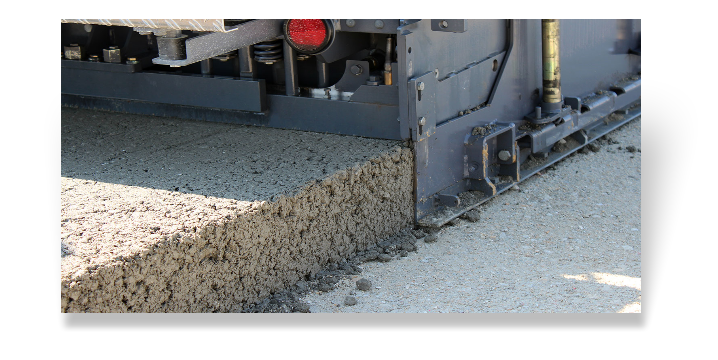by
Jose Reyes
| Mar 09, 2017
Roller Compacted Concrete pavement is best described as a zero slump concrete that is placed with standard or high-density paving equipment and consolidated/compacted using steel-drum or rubber-tired rollers to achieve a durable, wear resistant surface.
Roller-Compacted Concrete pavements were first used in the 1970’s for stabilization of logging roads in the US and Canada. It has proven to be a very effective heavy duty pavement that can stand up to harsh climates, heavy wheel loads and difficult operating conditions. Typically, Roller-Compacted Concrete has been used for heavy duty pavements such as log handling yards, intermodal terminals, freight depots, and other industrial applications. However, more recently there has been an increase in the use of Roller-Compacted Concrete to create cost-effective pavements for many conventional highway and street applications.

Speed of Construction
Perhaps the biggest benefit of Roller Compacted Concrete pavement is that it can be constructed more quickly and cost-effectively than conventional concrete or most asphalt pavements. Roller Compacted Concrete is placed with conventional or high-density asphalt-type paving equipment and compacted with rollers, eliminating the need for forming and finishing. In most cases, Roller Compacted Concrete can be competed in one pass. Extremely heavy-duty pavements requiring thicknesses greater than 10 inches may require two lifts. Because of its density and compaction, Roller Compacted Concrete can achieve sufficient load carrying capacity quickly and has, in some instances, been open to traffic within 24 hours after placement
Durability
Roller Compacted Concrete is a rigid pavement which will easily withstand the load form repetitive traffic. Because it can more evenly carry heavy loads, Roller Compacted Concrete will not rut from heavy axle loads, nor will it shove or tear from turning or braking vehicles. Additionally, Roller Compacted Concrete has all of the durability of conventional concrete pavement including resistance to fuels, oils, solvents and other fluids, and the ability to withstand the extremes of summer heat and winter cold. A properly designed Roller Compacted Concrete pavement will easily provide 20+ years of service.
Low Maintenance
Similar to conventional concrete, Roller Compacted Concrete has fewer repairs over its service life. There is no seal coating or resurfacing required. Aside from an occasional cleaning with a sweeper/vacuum, Roller Compacted Concrete maintenance requirements are minimal.
Competitive Cost
There are numerous cost savings associated with Roller Compacted Concrete. Historically, Roller Compacted Concrete has been comparable in cost to asphalt pavement. With rising oil/asphalt costs, Roller Compacted Concrete may actually be lower in initial paving costs. When compared to conventional concrete paving costs, Roller Compacted Concrete can provide savings of 25% to 30%. And owners will appreciate the lower Life-Cycle cost associated with Roller Compacted Concrete’s low maintenance requirements.
Sustainability
Roller Compacted Concrete pavements are environmentally friendly. Supplementary cementitious materials such as fly ash and ground granulated blast furnace slag can be used, reducing the amount of Portland cement and thus lowering the embodied energy of an Roller Compacted Concrete mix.
Roller Compacted Concrete’s lighter color provides greater light reflectivity, which means brighter and safer surroundings as well as lower lighting requirements. In fact, Roller Compacted Concrete pavement can reduce energy consumption by as much as 37% by either reducing the number of light fixtures needed or by allowing lower wattage light.
The lighter color of Roller Compacted Concrete also means less heat is absorbed, resulting in cooler communities. Utilizing a lighter colored pavement such as Roller Compacted Concrete can reduce ambient air temperatures by as much as 7-10 degrees.
Roller Compacted Concrete pavements have a solar reflectance index (SRI) greater than the minimum 29 that is necessary to obtain the appropriate credits for heat island mitigation – non-roof in the USGBC’s LEED Green Building Rating System.
Source: RollerCompacted